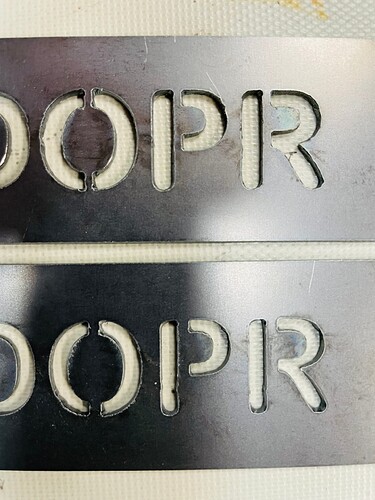Hello,
I was wondering what other people are using for their Kerf width setting when setting up a tool in Sheetcam. I’m using a new Thermal Dynamics Cutmaster 40 with 30 amp tip. To date all of my cuts on 16 gauge steel plate have been at 30 amps.
I’ve been cutting out different jobs designed in Inkscape and tool paths created in Sheetcam.
The majority of my jobs have a kerf setting in sheetcam of .60 inches. I started using this setting as it was the default when I first started using Sheetcam. However, now that I’ve been working with the Crossfire since January of this year I started to experiment with a kerf size of .03 inches in Sheetcam for comparison. I selected this size after I measured (with calipers) the actual kerf width of completed jobs. The .03 kerf width has been consistent when cutting at speeds of 100 to 175 ipm. I’m probably getting a slightly wider kerf width as I slow down the travel speed but not by much.
Yesterday I cut out two test pieces using kerf settings of .03 inches and .06 inches.
I’m uploading two pictures of these pieces.
K03 = .03" and K06 = .06".
I measured the dimensions of the text and rectangle in Inkscape and then measured the dimensions of the actual test cuts for comparison. What I found was that the kerf setting of .03" provided the correct size replication from Inkscape for the final cuts. The .06" setting was off from what was expected but still produced something close to what was designed.
When it comes to designing smaller more intricate jobs the .03" setting makes the process of creating the tool paths in Sheetcam a lot easier.
So again, I’m just curious to see what other people are doing and why.
what size are those letters and what thickness are you cutting?
The letters are .75" tall. The thickness is 16 gauge (.059")
I ask as your cutst seem a little wavy…check your torch height…pause/stop your torch mid cut…measure the height it looks like it might be too high off the metal…
try a different speed…possibly a little faster…increase by 3ipm.
I’ll check that out the next time. Thanks.
Screw all the bogus advice you’ve gotten. Cut a 2-3" square. Use any kerf setting you think is close. Measure the resulting square. It’s error from 2.0000" is the error in your kerf setting. Adjust the setting to 1/2 the error (+/-) depending on whether it’s an inside cut or an outside cut.
This is not rocket science.
what???
Makes sense. Thanks for the input.
The other option would be cut a square but use a center line cut. when you measure the difference between the square you cut and the square you laid out that difference will be your Kerf width exactly.
Always plenty of help here. Thanks @TinWhisperer . I’ll post my results after a few more tests.
Remember that kerf width will also change some with speed of cut and when you change cutting tip sizes.

